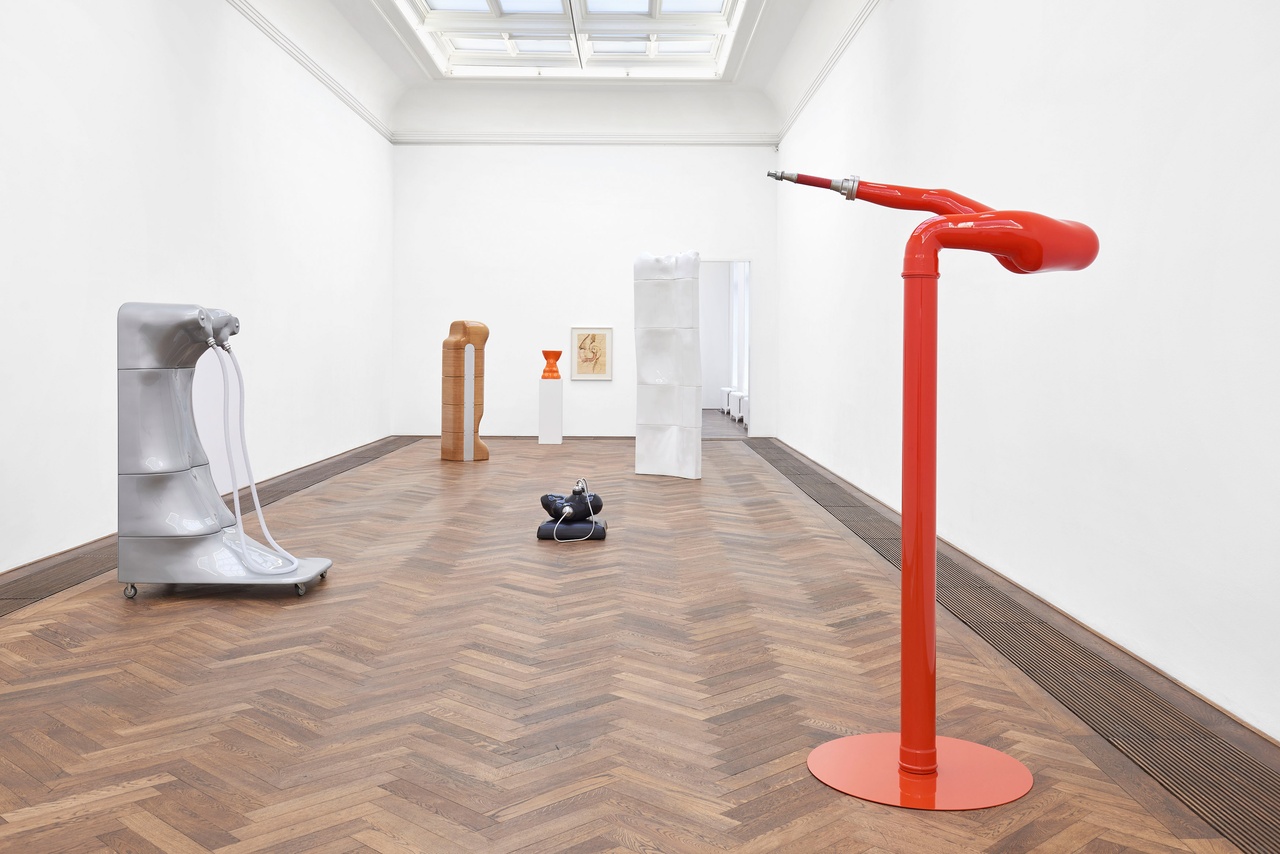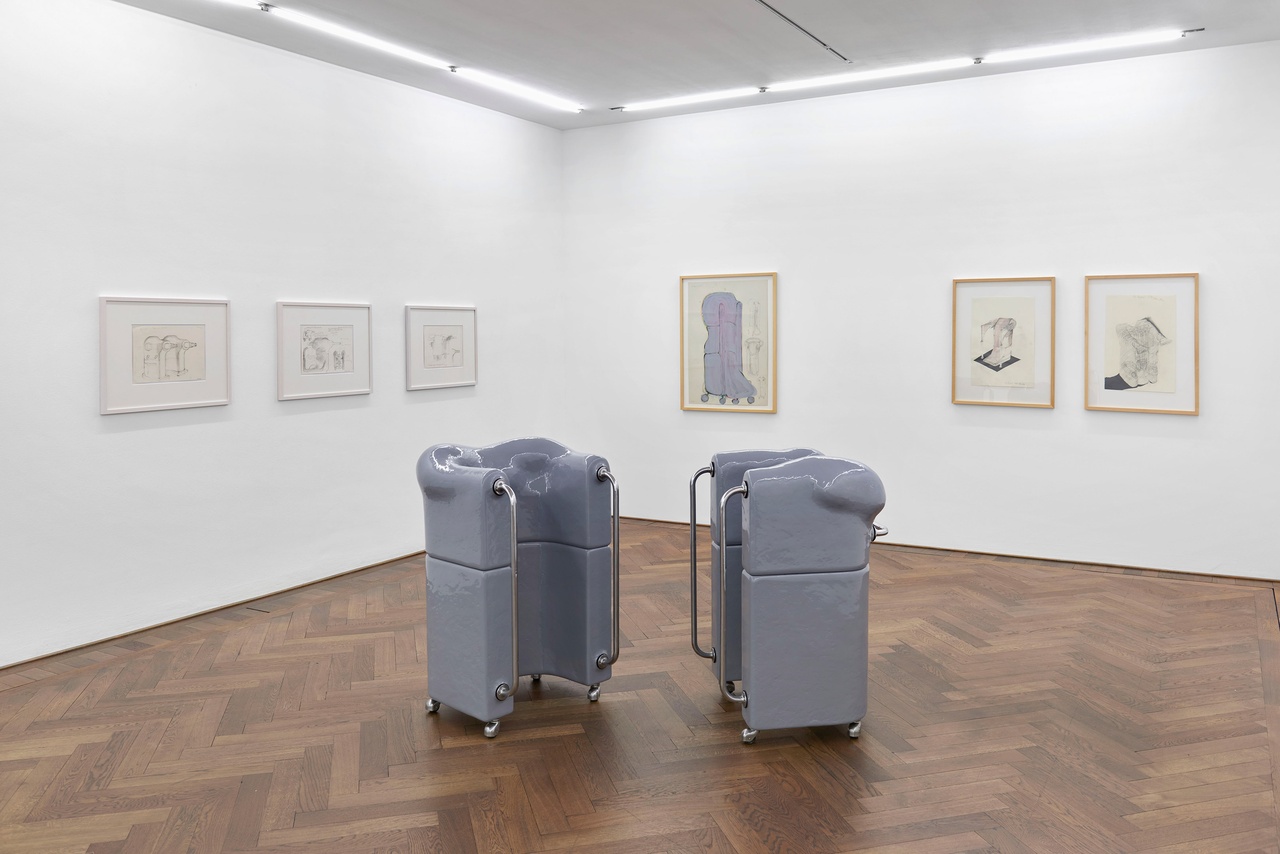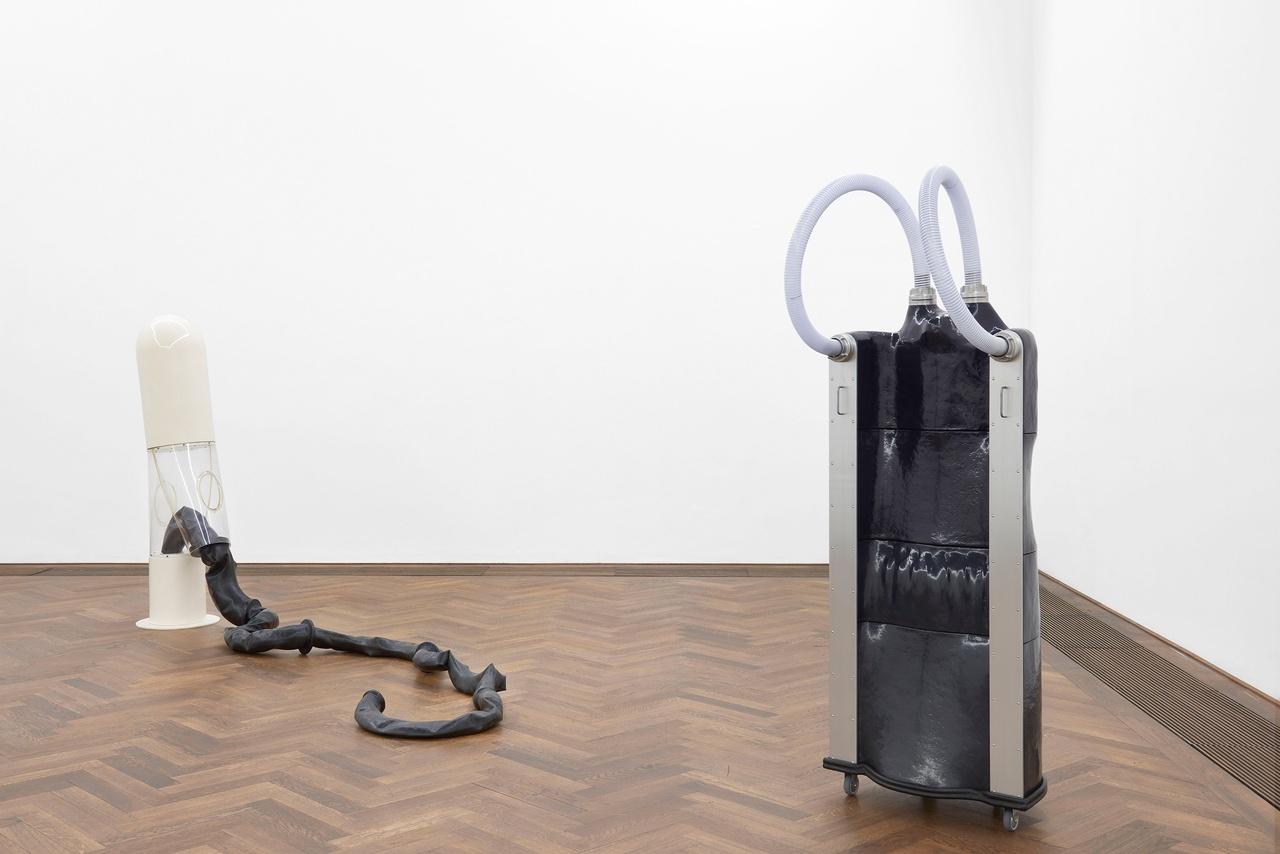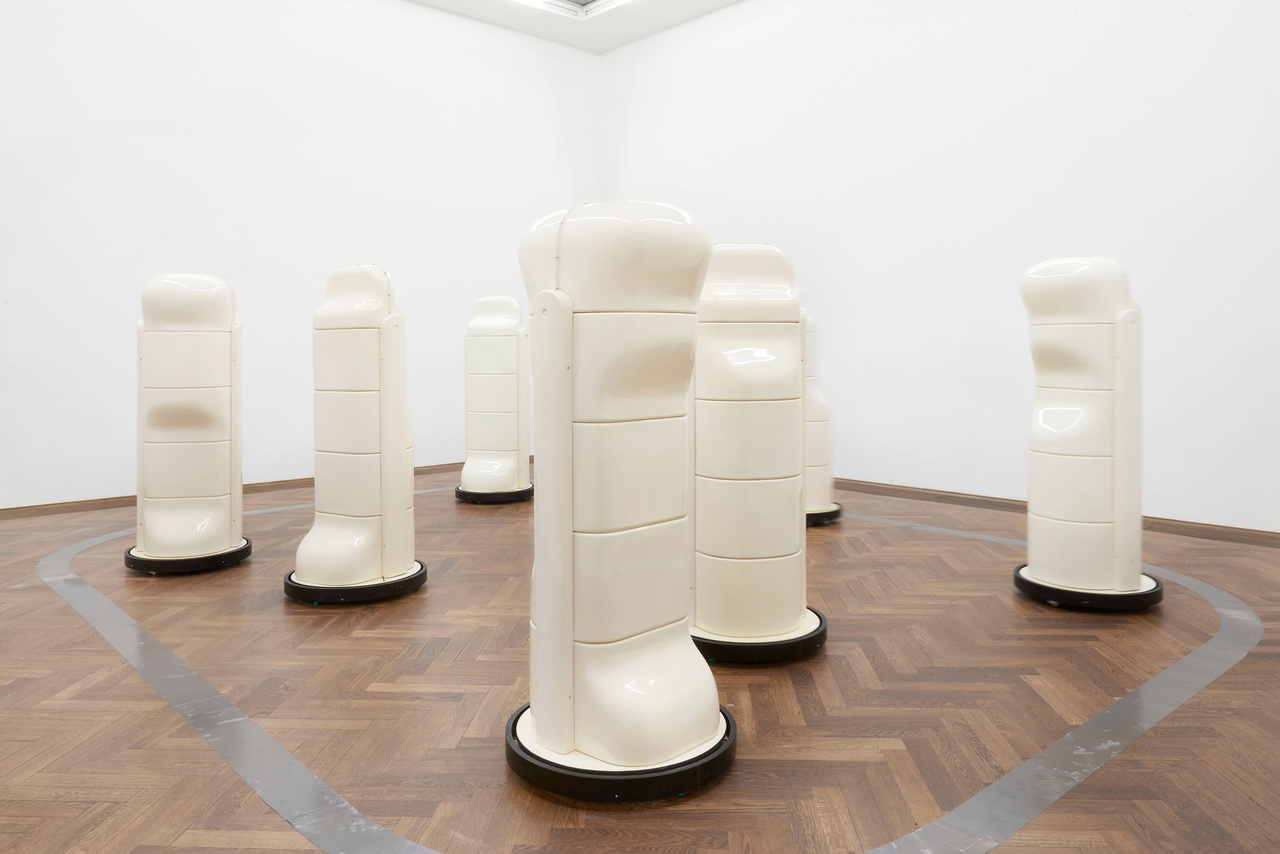THE NON-BEAUTIES Carlos Kong on Joachim Bandau at Kunsthalle Basel

“Joachim Bandau: Die Nichtschönen, Werke 1967–1974,” Kunsthalle Basel, 2021, installation view
Dormant tube monsters, organ devices, prosthetic leg coffins, white sarcophagi: these are just some of the seductive and terrifying forms that abound in Joachim Bandau’s early sculptures. Born in Cologne in 1936, the 85-year-old artist produced this daring body of work in a prolific spurt from 1967 to 1974. To construct these austere machinic-humanoid sculptures, Bandau first cut up department store mannequins and covered the severed segments in fiberglass-reinforced polyester. Exhuming new figures from bodily fragments, the artist then coated the fiberglass forms with lacquer or rubber and fitted them with new limbs and orifices of handlebars, wheels, tubes, and showerheads. The resulting sculptures – “non-beauties” (Nichtschönen), as Bandau calls them – baffle our taxonomies. At once biomorphic and industrial, they blur the boundaries of human and machine through the abstraction of the body, despite remaining resolutely figurative. Some rarely or never exhibited since their production, Bandau’s early sculptures and related drawings are reassembled in Kunsthalle Basel’s “Joachim Bandau: Die Nichtschönen, Works 1967–74.” The exhibition revives this body of work from its relative obscurity and positions it as a critical precursor to contemporary practices.
Presented in non-chronological, loosely thematic groupings across five galleries, Bandau’s early works explore the body’s implication in fascism and its aftermath. The artist’s use of the mannequin as a medium foregrounds his interest in “what a human figure can be, what makes a human figure, what happens to human beings.” [1] In probing the limits of the human, Bandau confronted his fraught historical milieu marked by the effects of curtailed denazification, the ideological fronts of the Cold War, industrial automation, the liberationist struggles of May ’68, and the terror of the RAF. The deep ambivalence of the body in Bandau’s work testifies to these tumultuous years, which witnessed the enlisting of bodies in political domination as well as their willful resistance to continual violence.

“Joachim Bandau: Die Nichtschönen, Werke 1967–1974,” Kunsthalle Basel, 2021, installation view
Across Bandau’s sculptures, the mannequin segments appear with varying degrees of legibility. Their human forms are at times outwardly recognizable, and at others, fully hidden. Most often, they beckon beneath their plasticized surfaces as part-objects within the modular components of machinic assemblages. Unnervingly confounding the limits of inside and outside, surface and depth, foreign and familiar, they prompt the viewer’s obsessive search for what remains of the body. In Ophelia, Badewassergrün (Ophelia, Bathwater Green, 1967), visible on the floor upon entry to first gallery, humanoid bumps emerge from the lustrous surface of a segmented seafoam green plank. Riffing on John Everett Millais’s iconic painting, the drowning Shakespearean heroine in Bandau’s rendition is genderless and nearly bodiless, verging on the inhuman as she fuses with her flat rectangular support. One of the earliest works to incorporate the mannequin, it inaugurates the paradoxical “aesthetics of violence” [2] at the core of Bandau’s sculptures. As implied in their nickname, the “non-beauties” do not negate beauty in favor of ugliness, but arrest its distanced pleasure. Their perverse beauty arises from the artist’s self-reflexive complicity with his aestheticization of bodily violence, which sought to critique the violent manipulation of the body politic that he observed in his cultural surroundings.
Bandau’s relentless abstraction and mechanization of the body sidestep aesthetic categories (figurative versus abstract) and art historical narratives. The art historian David J. Getsy, for instance, argued that the “paradoxical combination of a refusal to represent the body and a reliance on it as analogue” led to the formation of “abstract bodies” in US American sculpture of the 1960s, which paralleled the emerging malleability of the body and gender in medical and social institutions of the decade. [3] Almost minimalist in their reduction, Bandau’s sculptures are also gender-thwarting abstract bodies. Yet they index the more sinister dimensions of the body’s mutability, particularly when set against the tabooed alignment of figurative art with fascism in their West German context. In Gnom (Gnome, 1969/1970), a shiny black blob rests on a black pillow, its body laced with steel shower heads and hoses. Endearing at first glance, it disturbs when the disastrous referent that inspired the work is revealed: a photograph of a war veteran, a full-body amputee unable to move but still technically alive. The adjacent Transplantationsobjekt VI (Kölner Spritze) (Transplantation Object VI [Cologne Syringe], 1968) recalls the first heart transplant conducted in 1967, an event that Bandau regarded not as a utopian extension of life, but as a threatening reminder of the body’s violation under the guise of scientific rationality, such as in Nazi medical experimentation. [4] In the red-orange sculpture, a mannequin pelvis is affixed atop a pole, its leg thinning out into a gun-like point as the transplanted body becomes a weapon. As abstract figures, both sculptures reveal the body as a site of ongoing damage in the endurance of biopolitical violence into the postwar period and up through today.

“Joachim Bandau: Die Nichtschönen, Werke 1967–1974,” Kunsthalle Basel, 2021, installation view
The monstrosity of Bandau’s sculptures is accentuated by the fetishistic appeal of their sleek surfaces, erotic curves, and direct references to commodity culture and product design. Bandau’s use of fashion mannequins points to their symbolic function of equating bodies and objects as agents of commodity fetishism, putting “the sex appeal of the inorganic” on display. [5] In O.T. (Untitled, 1971), Bandau sculpts mannequin segments into a rectangular stele topped with a phallic protrusion. Wrapped in metal-studded black rubber, the sculpture not only recalls bondage aesthetics; its puckered surface further conjures the automobile as a fetishized commodity in West Germany, its rubber skin discernible as a flayed tire inner tube.
Yet the fetishism of bodies, commodities, and their in-betweens awakens historical specters in Bandau’s works. For Freud, the designation of an object as a fetish is akin to “the stopping of memory in traumatic amnesia.” [6] Throughout Bandau’s sculptures, West Germany’s commodity fetishism, the cultural effect of its postwar capitalist reconstruction, is a result of blocked traumatic memory. In Weißes Duschtor (White Shower Gate, 1969), for instance, a white lacquered mannequin torso implanted with shower heads evokes a luxury home appliance, yet it remains inseparable from its latent image of Nazi extermination. The sculpture condemns the commodity’s ominous obfuscations amid West Germany’s “economic miracle,” in which the return to economic stability and a pretense of social prosperity eclipsed traumatic memories and genuine mourning.

Joachim Bandau, “Georgische Tänzer,” 1971
Two of Bandau’s sculptures in the exhibition’s final rooms most forcefully bear on the present. In Wasserwerfer (Water Cannon, 1974), a mannequin segment juts out atop a black apparatus on wheels, its thighs whittled into cannon barrels. Invoking the water cannons used to suppress anti–Vietnam War demonstrations in Berlin, the instrument glimpses the ongoing brutality of similar devices, tear gas, and surveillance deployed by rogue governments and police forces worldwide to suppress public expressions of dissent and grief. Yet what haunts the present most is Bandau’s Georgische Tänzer (Georgian Dancers, 1971). In the multi-part work, Bandau installed a series of white ghostlike robots composed of modular segments on automated motors. Menacingly drifting in their own gallery, the dancers’ motors are programmed to pause and change direction upon sensing the proximity of another figure. Neither dead nor alive, these automata exude from their own historical moment the perilous individualism, impeded intimacy, and compromised solidarity that devastate our pandemic present. They reflect back to us what we most fear and dread we’ve already become – a mass of zombies, running on empty.
“Joachim Bandau: Die Nichtschönen, Works 1967–74,” Kunsthalle Basel, March 2–June 6, 2021.
Carlos Kong is a writer and art historian based in Berlin.
Image credit: Philipp Hänger / Kunsthalle Basel
Notes
| [1] | “Joachim Bandau at Kunsthalle Basel,” video, 13:04, January 2021, https://www.youtube.com/watch?v=V8_Xy9ajBd4. |
| [2] | The artist’s own term, quoted in the exhibition text: https://www.kunsthallebasel.ch/wp-content/uploads/Exhibitiont-ext-Joachim-Bandau-Kunsthalle-Basel.pdf |
| [3] | Getsy foregrounds how abstract sculpture intimated the dissociation of bodily sex from the lived experience of gender plurality in the 1960s, beginning with the proliferation of sex-change operations and transsexuality in cultural discourses of the 1950s. In its different geographical context, Bandau’s abstraction is centrally concerned with the malleability of the body and gender in the 1960s, but takes as one of its reference points the first heart transplant in 1967 (as later discussed). See David J. Getsy, Abstract Bodies: Sixties Sculpture in the Expanded Field of Gender (New Haven: Yale University Press, 2015), xvii. |
| [4] | Bandau’s understanding of the heart transplant parallels philosopher Jean-Luc Nancy’s account of his own heart transplant, in which “Man becomes what he is: the most terrifying and troubling technician … He who is capable of the origin and the end.” See Jean-Luc Nancy, “L'Intrus,” CR: The New Centennial Review 2, no. 3 (Fall 2002), 13. |
| [5] | This is Walter Benjamin’s definition of the fetishism of fashion. See Walter Benjamin, “Paris, the Capital of the Nineteenth Century,” in The Arcades Project (Cambridge, MA: Harvard University Press, 1999), 8. |
| [6] | Sigmund Freud, “Fetishism,” The Standard Edition of the Complete Psychological Works of Sigmund Freud, vol. 21, 1927–1931 (London: Hogarth Press, 1968), 155. |
